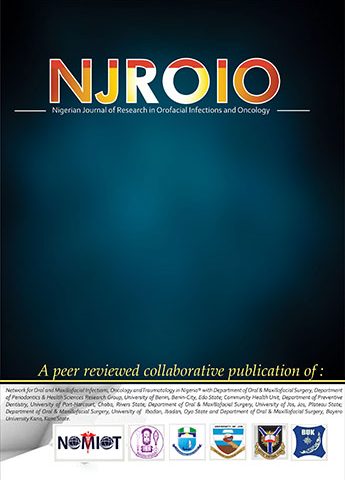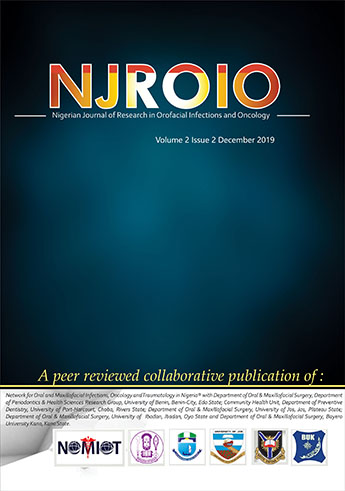
Volume 1 Issue 1 & 2
February 7, 2019
Volume 2 Issue 1
November 7, 2019CONTENT
The Head and Neck Tumours in Benin-City, Nigeria: Any Correlation with Risk Factors?
Objective:The objective of this study was to examine the clinical presentations of the head and neck tumours (HNTs) in Benin-City, Nigeria and to assess if any correlations exist with the known risk factors.
Methods: This study was a prospective clinical study involving all consecutive and consenting patients presenting with symptoms and signs suggestive of head and neck cancers to the Department of Ear Nose Throat Head and Neck Surgery, University of Benin Teaching Hospital, Benin-City, Nigeria. The study was done between January 2012 and December 2016. Data for the study were obtained by clerkship, physical examination, radiological examination and histological assessment.
Results: Age distribution of the patients revealed a rise in head and neck tumours from the 4th decade, to a peak in the 6th decade. Thereafter a decline through the 7th, 8th and 9th decades. Gender distribution of the patients showed that more males (78, 70.0%) are involved than the females (33, 30.0%). Alcohol intake and smoking were the most common identified risk factors to developing HNTs. The least implicated in this study were asbestos, heavy metals and family history. Smoking appeared to be a predictor of the HNTs (t, -2.902; sig, 0.005). The most common histologic diagnosis was squamous cell carcinoma accounting for 71.2% of all the cases; with more than half of these described as well differentiated.
Conclusion: HNTs are related with risk factors such as smoking, alcohol and exposures to hydrocarbons; though with low reportage. The authors expressed the opinion that increased national reportage and creating awareness of the risk factors will go a long way to minimize incidence and therefore suggest equipping of regional cancer centers and appropriate h a view to reducing the burden of cancers in Nigeria.
Awareness, Risk Perception and Expressed Feelings Towards People Living with HIV/AIDS among Nigerian Dental Patients
Objective: HIV/AIDS related issues among dental patients have been relatively understudied. The objective of this study was to assess the awareness, risk perception and expressed feelings towards people living with HIV/AIDS among dental patients
Methods: This cross-sectional study was conducted among adult male and female dental patients attending University of Benin Teaching Hospital, Benin City between August, 2016 and October, 2017. The obtained data were subjected to univariate analysis in form of frequencies, percentages and means and bivariate analysis in form of cross-tabulations using IBM SPSS version 20.0. The test for significance was done with Chi-square statistics and statistical significance was set at P<0.05.
Results: Awareness of HIV/AIDS was expressed by 93.4% of the participants. Health workers were the leading source of information among the participants on HIV/AIDS. Nearly half of the participants described HIV infection as serious and deadly. About two-thirds (61.9%) and one-tenth (9.4%) of the participants felt sorry and disgusted towards people living with HIV/AIDS respectively. About two-thirds (65.6%) of the participants expressed zero risk to HIV/AIDS. Younger people, males, singles, lower income earners, less religious participants, previous dental visitors and those that know someone who has or is suspected of having HIV/AIDS reported lower HIV/AIDS perception risk
Conclusion: HIV/AIDS awareness was high with multiple sources of information among the participants. Self-perceived risk toward HIV was low but expressed feeling toward people living with HIV/AIDS was predominantly sympathetic. Strategies that focus on influencing risk-perception are deemed necessary to facilitate zero transmission of the infection.


